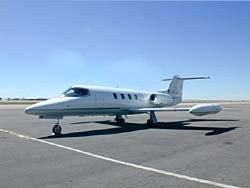Admits He Was Flying Illegally In 2002 Crash
 Court records in a Florida civil
suit show the copilot of a Lear 25CXR admits he falsified his
proficiency test results and was flying illegally when the aircraft
went down more than two years ago, when it veered from the runway
on landing at Blue Grass Airport in Lexington, KY. The patient on
board that medical transport flight, 76-year old Louise Babb, was
killed. Her husband, the flight crew and the attending nurse were
all seriously injured.
Court records in a Florida civil
suit show the copilot of a Lear 25CXR admits he falsified his
proficiency test results and was flying illegally when the aircraft
went down more than two years ago, when it veered from the runway
on landing at Blue Grass Airport in Lexington, KY. The patient on
board that medical transport flight, 76-year old Louise Babb, was
killed. Her husband, the flight crew and the attending nurse were
all seriously injured.
Now, widower John Babb and his son, Mitchell Blumenfeld, are
suing American Air Network, Air Ambulance Care Flight
International, pilot Miles Lansing and copilot Jim Hensel, as well
as companies that maintained the aircraft for what they call Louise
Babb's wrongful death.
The flight, which originated at Marco Island, FL, was landing,
when the NTSB finding takes up the story:
Shortly before landing, the crew confirmed that the hydraulic
and emergency air pressures were "good", and that the circuit
breakers on the "right and left" were in. In addition, the first
officer reported "arming one and two."
 The airplane (file photo of type,
right) landed 1,000 - 1,500 feet from the landing threshold of
runway 04, which was 7,003 feet in length. The captain utilized
aerodynamic braking during part of the landing roll. About 3
seconds after touchdown, the first officer stated, "they're not
deployed, they're armed only." About 6 seconds after touchdown,
there was an increase in engine rpm. Shortly after that, there was
an expletive from the captain. One and a half seconds later, there
was another expletive. Slightly less than 2 seconds later, the
captain told the first officer to "brake me," and 2.7 seconds after
that, stated "emergency brake." About 4 seconds later, there was a
"clunk", followed by a decrease in engine rpm 1 second later.
Immediately after that, the captain stated, "we're going off the
end."
The airplane (file photo of type,
right) landed 1,000 - 1,500 feet from the landing threshold of
runway 04, which was 7,003 feet in length. The captain utilized
aerodynamic braking during part of the landing roll. About 3
seconds after touchdown, the first officer stated, "they're not
deployed, they're armed only." About 6 seconds after touchdown,
there was an increase in engine rpm. Shortly after that, there was
an expletive from the captain. One and a half seconds later, there
was another expletive. Slightly less than 2 seconds later, the
captain told the first officer to "brake me," and 2.7 seconds after
that, stated "emergency brake." About 4 seconds later, there was a
"clunk", followed by a decrease in engine rpm 1 second later.
Immediately after that, the captain stated, "we're going off the
end."
The airplane subsequently dropped off an embankment at the end
of the runway, impacted and descended through a localizer tower,
then impacted the ground and slid across a highway. The airplane
had been fitted with a conversion that included thrust reversers.
An examination of the wreckage revealed that the thrust reversers
were out of the stowed position, but not deployed. The drag chute
was also not deployed. Brake calipers were tested with compressed
air, and operated normally. Brake disc pads were measured, and
found to be within limits. According to an excerpt from the
conversion maintenance manual, reverser deployment was
hydraulically actuated and electrically controlled.
T
 here was also an accumulator which
allowed deploy/stow cycling in the event of hydraulic system
failure. Interlocks were provided so that the reverser doors could
not be deployed until the control panel ARM switch was on, the main
throttle levers were in idle position, and the airplane was on the
ground with the squat switches engaged. The previous crew reported
no mechanical anomalies. Runway elevation rose by approximately 35
feet during the first 2/3 of its length, then decreased until it
was 8 feet lower at its departure end. Winds were reported as being
from 050 degrees true at 7 knots. At the airplane's projected
landing weight, without the use of thrust reversers, the estimated
landing distance was about 2,850 feet with the anti-skid operative,
and 3,400 feet with the anti-skid inoperative.
here was also an accumulator which
allowed deploy/stow cycling in the event of hydraulic system
failure. Interlocks were provided so that the reverser doors could
not be deployed until the control panel ARM switch was on, the main
throttle levers were in idle position, and the airplane was on the
ground with the squat switches engaged. The previous crew reported
no mechanical anomalies. Runway elevation rose by approximately 35
feet during the first 2/3 of its length, then decreased until it
was 8 feet lower at its departure end. Winds were reported as being
from 050 degrees true at 7 knots. At the airplane's projected
landing weight, without the use of thrust reversers, the estimated
landing distance was about 2,850 feet with the anti-skid operative,
and 3,400 feet with the anti-skid inoperative.
The National Transportation Safety Board determines the probable
cause(s) of this accident as follows:
The captain's addition of forward thrust during the landing
rollout, which resulted in a lack of braking effectiveness and a
subsequent runway overrun. A factor was the captain's inability to
deploy the thrust reversers for undetermined reasons.
During a deposition last summer, Hensel was confronted with a
check ride document dated June 22, 2002. The document indicated
Hensel had passed.
 "This entire document is one big
giant lie, correct?," Chicago attorney David Rapoport asked.
"This entire document is one big
giant lie, correct?," Chicago attorney David Rapoport asked.
"Correct," Hensel replied, according to the deposition. He then
admitted that he lacked the "lawful qualification" necessary to fly
that day.
So who "pencil-whipped" the check ride? An American Air official
who, according to court records, continues to say he indeed gave
Hensel that check ride.
"Crucial pilot records were intentionally falsified by one of
the highest ranking officials" at the air carrier company," said
the motion filed in a Pinellas County Circuit Court, FL and
reported by the Lexington Herald-Leader. ”Pencil whipping
records to show a pilot possesses qualifications he really lacks is
despicable and dangerous conduct that compromises public safety,"
the motion said.
 ANN's Daily Aero-Term (04.20.24): Light Gun
ANN's Daily Aero-Term (04.20.24): Light Gun Aero-News: Quote of the Day (04.20.24)
Aero-News: Quote of the Day (04.20.24) ANN's Daily Aero-Linx (04.21.24)
ANN's Daily Aero-Linx (04.21.24) Aero-News: Quote of the Day (04.21.24)
Aero-News: Quote of the Day (04.21.24) ANN's Daily Aero-Term (04.21.24): Aircraft Conflict
ANN's Daily Aero-Term (04.21.24): Aircraft Conflict






